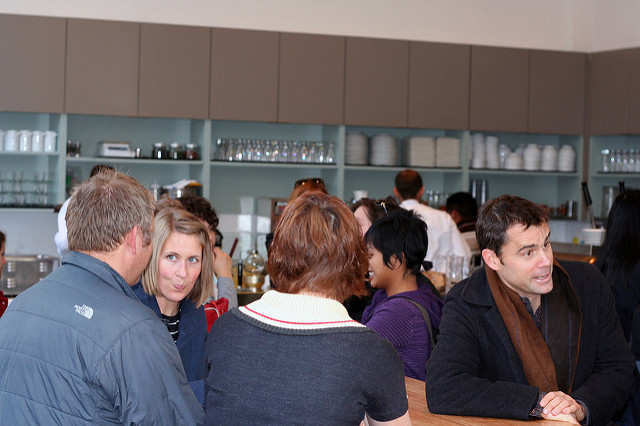Unlock the Magic in Your Story Now
Get the Free 20 questions to Ask Before Launching Your Idea workbook when you sign up for occasional updates.
Get the Free 20 questions to Ask Before Launching Your Idea workbook when you sign up for occasional updates.
Articles filed in: Marketing
The Three Steps To Articulating Value
filed in Marketing, Storytelling
 It’s tempting to begin with product and service descriptions when you are communicating the value your business creates. Of course, it’s easier to start with what we know for sure. We list features, benefits and specifications—telling the customer as much as we can about ‘the what’.
It’s tempting to begin with product and service descriptions when you are communicating the value your business creates. Of course, it’s easier to start with what we know for sure. We list features, benefits and specifications—telling the customer as much as we can about ‘the what’.
And all the while we’re doing it backwards.
Intead of starting with our ‘what’ we need to begin with the customer’s ‘why’.
How To Articulate Value
1. Why does the customer need your product?
Reflect the customer’s challenges or desires back to him.
2. How will it work?
Describe the change the product will create.
3. What is it?
Finish with the facts.
Very few of our buying decisions are led by reason and logic, so why seek to persuade by starting there?
Image by Mike Melrose.
Beyond The Point Of Sale
 Many marketing strategies focus on the point of sale.
Many marketing strategies focus on the point of sale.
Most great brand stories focus on what happens before and after the point of sale.
We win by considering who the customer is, and helping him to become who he wants to be.
This happens by understanding his story beyond the point of sale.
Image by Linh Nguyen.
Optimising For Customer Delight And The Peak-End Rule
 Jody and Jim (not their real names) run a small web design studio. Their initial pricing strategy was to keep base prices low, putting time caps on every deliverable during the website design and build. New clients were informed about this policy up front. Things like design time and content population were included in the original quote. If the project became more complex or the client wanted changes, the design team let them know that they would incur an extra charge and got their approval to go ahead.
Jody and Jim (not their real names) run a small web design studio. Their initial pricing strategy was to keep base prices low, putting time caps on every deliverable during the website design and build. New clients were informed about this policy up front. Things like design time and content population were included in the original quote. If the project became more complex or the client wanted changes, the design team let them know that they would incur an extra charge and got their approval to go ahead.
Despite this, when clients were presented with a ‘higher than expected’ bill at the end of the project they were very annoyed. They were thrilled with their website but not at all happy with Jody and Jim. The result was unhappy clients, negative reviews and fewer word of mouth referrals.
Something had to change. The priority was to leave every client delighted at the end of the experience. A smart move on Jody and Jim’s part when you consider peak-end rule.
The team decided to simply increase prices to reflect the fact that every single web design project goes out of scope. Now at the end of a job, the client is delighted with both their website and the company—all as a direct result of this firm pricing strategy.
The ability to truly empathise with the customer along every step of their experience is what separates great businesses from good ones. How are you doing that?
Image by Leo Hidalgo..
The Importance Of Happy Endings
 When we’re serving customers we tend to front-load our effort. Hotel reception staff are well-versed in making a great impression when the guest checks in. Good waiters quickly seat new diners and take orders promptly. Retailers station greeters at the store entrance to welcome and orient new customers.
When we’re serving customers we tend to front-load our effort. Hotel reception staff are well-versed in making a great impression when the guest checks in. Good waiters quickly seat new diners and take orders promptly. Retailers station greeters at the store entrance to welcome and orient new customers.
The same is also true for marketing. We expend a lot of effort to attract customers, committing a significant chunk of our resources to getting them through the door.
The trouble is that customers don’t rate the quality of their overall experience by what happens moment to moment, they judge it by what happened at its peak and at the end. This is why as business leaders and marketers we need to pay attention to the peak-end rule.
How you say goodbye is just, if not more important, as how you said hello.
Image by Stijn Nieuwendijk.
The Facts Are Overrated
 Since the new Model 3 Tesla was unveiled just over two weeks ago 400,000 people (who have never test driven or sat in one) have paid $1000 to place an order. And while the price of this latest model makes it accessible to more people it’s clearly not what’s driving these organic sales.
Since the new Model 3 Tesla was unveiled just over two weeks ago 400,000 people (who have never test driven or sat in one) have paid $1000 to place an order. And while the price of this latest model makes it accessible to more people it’s clearly not what’s driving these organic sales.
Think about the last significant purchase you made—a car, kitchen appliance or mobile phone. How deeply did you dive into the details about the features and functionality before you decided which product to buy? When were you last persuaded by facts?
Now think about how you differentiate your products and services. Do you default to competing on features, benefits and price alone? What’s at the heart of your story?
Yes, the facts had better stack up, but they’re not what’s driving your customer’s decisions.
Image by Wendell.
The Power Of Promises
 “You’ll have it by Friday.”
“You’ll have it by Friday.”
“I’ll call you tomorrow.”
“We’ll be there by 3pm.”
How many times have promises like these been made to you in the past few weeks, only to be casually broken and replaced by a fresh set soon after?
Doing what you say you’ll do is the fastest route to building credibility, trust, and loyalty.
The ability to keep the promises you make is your new competitive advantage.
Grow Your Business By Watching What People Do
filed in Marketing, Storytelling, Strategy
 I once walked the length for Bourke Street behind a young man in a hurry heading towards Southern Cross Station. His backpack was slung over one shoulder and a designer shopping bag in the other hand bumped his knee as he walked revealing the Christian Louboutin logo. When we both stopped at the lights I couldn’t resist asking him what he’d bought. The shoes, he told me were a gift for a girlfriend he was trying to “win back”. The gesture had to be unforgettable.
I once walked the length for Bourke Street behind a young man in a hurry heading towards Southern Cross Station. His backpack was slung over one shoulder and a designer shopping bag in the other hand bumped his knee as he walked revealing the Christian Louboutin logo. When we both stopped at the lights I couldn’t resist asking him what he’d bought. The shoes, he told me were a gift for a girlfriend he was trying to “win back”. The gesture had to be unforgettable.
Christian Louboutin is one of the most successful shoe designers in the world, selling more than half a million pairs of shoes a year. A pair of Louboutin’s will set you back between $395 and $6,000, their distinctive red soles are a marketing coup.
The root of the designer’s success is twofold. Firstly he knows who his customer is, and importantly who she is not, he doesn’t make shoes for “women who play bridge in the afternoon”. Secondly, he watches what she does and understands the role of his product in shaping her perception of herself.
Louboutin once said, “When a woman buys a pair of shoes, she never looks at the shoe. She stands up and looks in the mirror, she looks at the breast, the ass, from the front, from the side, blah blah blah. If she likes herself, then she considers the shoe.”
The opportunity to go deeper and gain valuable insights into our customers behaviour is open to each and every business. Those insights we observe can transform innovation, service and marketing.
How much time are you devoting to understanding how your customer’s actions drive their buying decisions?
Image by Adrain Scottow
What Do Your Customers Really Want?
filed in Marketing, Storytelling, Strategy
 There’s an Italian Cafe in our neighbourhood serving good coffee and speciality cakes. It’s jam-packed every single evening—not because people are hungry for cake, but because they are hungry for the feeling of being connected. They seek out the place that makes them feel that way.
There’s an Italian Cafe in our neighbourhood serving good coffee and speciality cakes. It’s jam-packed every single evening—not because people are hungry for cake, but because they are hungry for the feeling of being connected. They seek out the place that makes them feel that way.
Howard Schultz recognised the power of people’s aspirations thirty years ago, when he transformed Starbucks from a coffee roaster into ‘the third place’ by grounding the brand’s value proposition in a story about ritual and community.
Just as a successful cafe isn’t ever just about the coffee, the products and services you sell create meaning for your customers beyond their utility. The truth is that as marketers, we often miss the opportunity to acknowledge and reflect that story back to them.
Does your story align with the story your customers really want to believe?
Image by Niall Kennedy.
The Cost Of Interruption
 The web design firm can access thousands of contact details for newly registered domains each day. It’s easy from there to hire a bunch of poorly trained phone operatives (who are overqualified to do soulless work but need the money) to interrupt people.
The web design firm can access thousands of contact details for newly registered domains each day. It’s easy from there to hire a bunch of poorly trained phone operatives (who are overqualified to do soulless work but need the money) to interrupt people.
It’s possible to scrape, buy, trawl and interrupt a thousand people for next to nothing. What are we losing the opportunity to work on doing better by reaching for the lowest hanging fruit?
We count the cost of converting a prospect to a customer.
We rarely count the cost of treating people like ‘prospects’.
Image by Sullivan Gardner.
 The purpose of your brand story and of every piece of marketing material is to move a prospective customer from awareness to loyalty.
The purpose of your brand story and of every piece of marketing material is to move a prospective customer from awareness to loyalty.